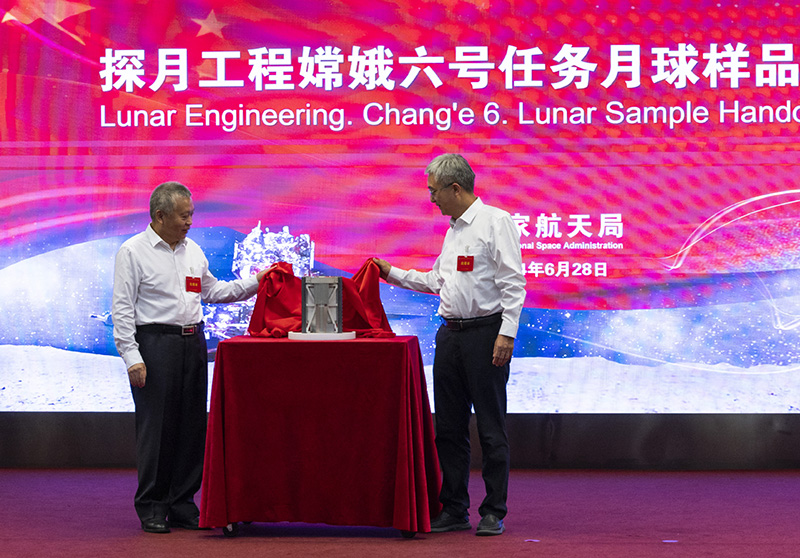
BEIJING, June 28 -- China's Chang'e-6 mission collected 1,935.3 grams of samples from the far side of the moon, preliminary measurement by the China National Space Administration (CNSA) showed Friday.
Zhang Kejian, head of the CNSA, handed over the sample container and sample certificate to Ding Chibiao, vice president of the Chinese Academy of Sciences (CAS), at a ceremony in Beijing.
Minister of Industry and Information Technology Jin Zhuanglong presided over the handover ceremony.
"We have found that the samples brought back by Chang'e-6 were more viscous compared to previous samples, with the presence of clumps. These are observable characteristics," Ge Ping, deputy director of the CNSA's Lunar Exploration and Space Engineering Center, who is also the spokesperson for the Chang'e-6 mission, told the press at the ceremony.
Researchers will then store and process the lunar samples as planned and initiate scientific research.
The lunar samples, which were collected from the far side of the moon for the first time in human history, hold unique scientific significance as they will further enhance the understanding of lunar evolution, accelerate the pace of peaceful exploration and utilization of lunar resources, and serve as an important asset for all humanity, the CNSA said.
The CNSA vowed to uphold the spirit of lunar exploration, characterized by "chasing dreams, daring to explore, collaborating to overcome challenges, and achieving win-win cooperation," to ensure the proper management of the samples.
The CNSA said it will organize scientific research on the samples and share China's lunar exploration achievements with the international community.
Based on the lunar sample management rules released by the CNSA and the experience in dealing with the applications for lunar samples collected by the Chang'e-5 mission, applications for the Chang'e-6 samples are expected to open to domestic research institutions and scientists in about six months, Ge said.
Regarding international applications, Ge noted that China has always maintained a positive and open attitude and welcomes scientists from all countries to submit applications following relevant procedures.
Chinese Vice Premier Zhang Guoqing, also a member of the Political Bureau of the Communist Party of China Central Committee, attended the handover ceremony.
Zhang stressed that the lunar samples be well managed and elaborate scientific research carried out to produce a number of world-class original scientific results, making new achievements in exploring the mysteries of the universe and enhancing the well-being of humanity.
Zhang added that China will continuously strengthen international cooperation in space missions, boost the innovative development of space science, technology, and applications, and promote the coordinated development of commercial and traditional space activities.
Later on Friday, Ding Chibiao handed the lunar samples to the National Astronomical Observatories under the CAS (NAOC).
"We will handle the samples with utmost care and ensure they are safely unsealed, scientifically processed, properly stored, and distributed according to the established management protocols," said Liu Jifeng, director of the NAOC.
"The sampling site of the Chang'e-6 mission is in the South Pole-Aitken (SPA) Basin, which is a gigantic impact crater. This presents an exceptional opportunity for us to gain insights into the early impact processes on the moon, thereby contributing to our understanding of the early evolution history of the solar system," Liu said.
"The scientific significance of the lunar samples is immense. We will organize scientists to conduct meticulous research, ensuring that not even the tiniest amount of the samples is wasted, to fully explore their profound scientific value," he added.
Previously, significant scientific achievements have been made through in-depth research on the lunar samples brought back by the Chang'e-5 mission in areas such as lunar formation and evolution, space weathering, and resource utilization, the CNSA said.
Researchers have published more than 80 achievements in important domestic and international journals, including the discovery of the new lunar mineral Changesite-(Y), the sixth discovered on the moon, and the "youngest" basalt on the moon, which was determined to be about two billion years old and extended the "life" of lunar volcanism 800-900 million years longer than previously known.
The Chang'e-6 probe was launched into orbit on May 3. On June 25, its returner, carrying the lunar samples, landed precisely in its designated area in Siziwang Banner, north China's Inner Mongolia Autonomous Region, marking the mission's complete success.
The Chang'e-6 returner safely arrived in Beijing later. Researchers opened it and successfully collected the lunar sample container on Wednesday, according to the CNSA.





